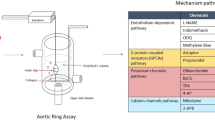Abstract
A flavonoid-rich diet has been associated with a lower incidence of cardiovascular diseases, probably because of the antioxidant and vasoactive properties of flavonoids. Indeed, many flavonoids show vasorelaxing properties, due to different and often not yet completely clarified mechanisms of action. Among them, the activation of vascular potassium channels has been indicated as a possible pathway, accounting, at least in part, for the vasodilatory action of some flavonoid derivatives, such as apigenin and dioclein. Therefore, this work aims at evaluating, on in vitro isolated rat aortic rings, the endothelium-independent vasorelaxing effects of a number of flavonoid derivatives, to identify a possible activation of calcium-activated and/or ATP-sensitive potassium channels and to indicate some possible structure–activity relationships. Among the several flavonoids submitted to the pharmacological assay, only baicalein and quercetagetin were almost completely ineffective, while quercetin, hesperidin, quercitrin and rhoifolin exhibited only a partial vasorelaxing effect. On the contrary, acacetin, apigenin, chrysin, hesperetin, luteolin, pinocembrin, 4′-hydroxyflavanone, 5-hydroxyflavone, 5-methoxyflavone, 6-hydroxyflavanone and 7-hydroxyflavone, belonging to the chemical classes of flavones and flavanones, showed full vasorelaxing effects. The vasodilatory activity of hesperetin, luteolin, 5-hydroxyflavone and 7-hydroxyflavone were antagonised by tetraethylammonium chloride, indicating the possible involvement of calcium-activated potassium channels. Moreover, iberiotoxin clearly antagonised the effects of 5-hydroxyflavone, indicating the probable importance of a structural requirement (the hydroxy group in position 5) for a possible interaction with large-conductance, calcium-activated potassium channels. Finally, glibenclamide inhibited the vasorelaxing action of luteolin and 5-hydroxyflavone, suggesting that ATP-sensitive potassium channels may also be involved in their mechanism of action.






Similar content being viewed by others
References
Aviram M, Fuhrman B (1998) Polyphenolic flavonoids inhibit macrophage-mediated oxidation of LDL and attenuate atherogenesis. Atherosclerosis 137:S45–S50
Balwierczak JL, Krulan CM, Kim HS, Del Grande D, Weiss GB, Hu S (1995) Evidence that BKCa channel activation contributes to K+ channel opener induced relaxation of the porcine coronary artery. Naunyn-Schmiedebergs Arch Pharmacol 352:213–221
Calderone V (2002) Large-conductance, Ca2+-activated K+ channels: function, pharmacology and drugs. Curr Med Chem 9:1385–1395
Calderone V, Chericoni S, Testai L, Morelli I, Martinotti E (2001) Role of potassium channels in the vasodilatator response of flavonoids naringine and naringenine. Congress of the Italian Society of Pharmacology, Taormina, 26th October, p 25
Cavero I, Djellas Y, Guillon JM (1995) Ischemic myocardial cell protection conferred by the opening of ATP-sensitive potassium channels. Cardiovasc Drugs Ther 9:245–255
Chan EC, Woodman OL (1999) Enhanced role for the opening of potassium channels in relaxant responses to acetylcholine after myocardial ischaemia and reperfusion in dog coronary arteries. Br J Pharmacol 126:925–932
Clark SG, Fuchs LC (2000) BK(Ca) channels compensate for loss of NOS-dependent coronary artery relaxation in cardiomyopathy. Am J Physiol Heart Circ Physiol 279:H2598–H2603
Cortes SF, Rezende BA, Corriu C, Medeiros IA, Teixeira MM, Lopes MJ, Lemos VS (2001) Pharmacological evidence for the activation of potassium channels as the mechanism involved in the hypotensive and vasorelaxant effect of dioclein in rat small resistance arteries. Br J Pharmacol 133:849–858
Duarte J, Vizcaìno FP, Utrilla P, Jiménez J, Tamargo J, Zarzuelo A (1993) Vasodilatatory effects of flavonoids in rat aortic smooth muscle. Structure–activity relationship. Gen Pharmacol 24:857–862
Fitzpatrick DF, Hirschfield L, Coffey RG (1993) Endothelium-dependent vasorelaxing activity of wine and other grape products. Am J Physiol 265:H774–H778
Herrera MD, Zarzuelo A, Jimenez J, Marhuenda E, Duarte J (1996) Effects of flavonoids on rat aortic smooth muscle contractility: structure–activity relationships. Gen Pharmacol 27:273–277
Hertog MG, Feskens EJ, Hollman PC, Katan MB, Kromhout D (1993) Dietary antioxidant flavonoids and risk of coronary heart disease: the Zutphen Elderly Study. Lancet 342:1007–1011
Knekt P, Jarvinen R, Reunanen A, Maatela J (1996) Flavonoid intake and coronary mortality in Finland: a cohort study. Br Med J 312:478–481
Li Y, Starret JE, Meanwell NA, Johnson G, Harte WE, Dworetzky SI, Boissard CG, Gribkoff VK (1997) The discovery of novel openers of Ca2+-dependent large-conductance potassium channels: pharmacophore search and physiological evaluation of flavonoids. Bioorg Med Chem Lett 7:759–762
Li Y, Johnson G, Romine JL, Meanwell NA, Martin SW, Dworetzky SI, Boissard CG, Gribkoff VK, Starrett JE Jr (2003) Novel openers of Ca2+-dependent large-conductance potassium channels: symmetrical pharmacophore and electrophysiological evaluation of bisphenols. Bioorg Med Chem Lett 13:1437–1439
Loffler C, Quast U (1997) Pharmacological characterisation of the sulphonylurea receptor in rat isolated aorta. Br J Pharmacol 120:476–480
Magnon M, Calderone V, Floch A, Cavero I (1998) Influence of vessel depolarisation on vasorelaxant potency and efficacy of Ca2+entry blockers, K+channel openers, nitrate derivatives, salbutamol and papaverine, in rat aortic rings. Naunyn-Schmiedebergs Arch Pharmacol 358:452–463
Mannhold R (2004) KATP channel openers: structure–activity relationships and therapeutic potential. Med Res Rev 24:213–266
Marijic J, Li QX, Song M, Nishimaru K, Stefani E, Toro L (2001) Decreased expression of voltage- and Ca2+-activated K+ channels in coronary smooth muscle during aging. Circ Res 88:210–216
Nardi A, Calderone V, Chericoni S, Morelli I (2003) Natural modulators of large-conductance calcium-activated potassium channels. Planta Med 69:885–892
Rice-Evans C, Miller NJ, Paganga G (1997) Antioxidant properties of phenolic compounds. Trends Plant Sci 2:152–159
Sargent CA, Grover GJ, Antonaccio MJ, McCullough JR (1993) The cardioprotective, vasorelaxant and electrophysiological profile of the large conductance calcium-activated potassium channel opener NS-004. J Pharmacol Exp Ther 266:1422–1429
Wu S-N, Li HF, Shen AY (1999) Activation of large-conductance Ca2+-activated K+ channels by pinacidil in human umbilical vascular endothelial cells. Drug Dev Res 48:6–16
Zhang YH, Park YS, Kim TJ, Fang LH, Ahn HY, Hong JT, Kim Y, Lee CK, Yhun YP (2002) Endothelium-dependent vasorelaxant and antiproliferative effect of apigenin. Gen Pharmacol 35:1–7
Author information
Authors and Affiliations
Corresponding author
Rights and permissions
About this article
Cite this article
Calderone, V., Chericoni, S., Martinelli, C. et al. Vasorelaxing effects of flavonoids: investigation on the possible involvement of potassium channels. Naunyn-Schmiedeberg's Arch Pharmacol 370, 290–298 (2004). https://doi.org/10.1007/s00210-004-0964-z
Received:
Accepted:
Published:
Issue Date:
DOI: https://doi.org/10.1007/s00210-004-0964-z




